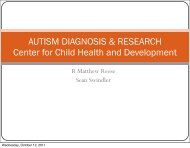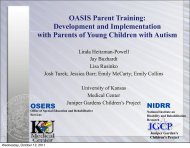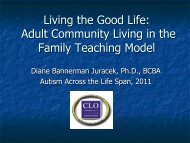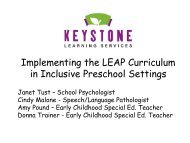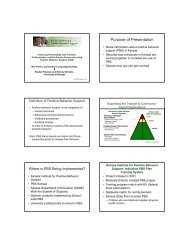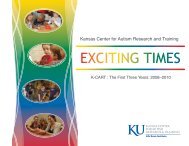Presentation - The Kansas Center for Autism Research and Training
Presentation - The Kansas Center for Autism Research and Training
Presentation - The Kansas Center for Autism Research and Training
You also want an ePaper? Increase the reach of your titles
YUMPU automatically turns print PDFs into web optimized ePapers that Google loves.
Introduction to the TEACCH Transition<br />
Assessment Profile, K-CART Conf.<br />
October 14, 2010<br />
+ Revised AAPEP becomes the TTAP<br />
7<br />
+ Rationale <strong>for</strong> using the TTAP<br />
8<br />
TEACCH Transition Assessment Profile<br />
Authors:<br />
Gary Mesibov<br />
John B. Thomas<br />
S. Michael Chapman<br />
Eric Schopler<br />
Published: 2007 by<br />
PRO-ED, Inc.<br />
www.proedinc.com<br />
Addresses the Requirements of US Law:<br />
Comprehensive Formal Assessment by age 14-16 (few<br />
instruments <strong>for</strong> students with ASD)<br />
Addresses Principal Transition Areas<br />
Identifies Strengths <strong>and</strong> Interests<br />
Assessment Across Contexts:<br />
Family <strong>and</strong> School as well as Vocational<br />
Provides goals <strong>for</strong> IEP/ITP related to postsecondary<br />
outcomes<br />
+ Rationale <strong>for</strong> using the TTAP (2)<br />
9<br />
Addresses the requirements of IDEA:<br />
Provides a method <strong>for</strong> ongoing In<strong>for</strong>mal<br />
Assessment<br />
Provides “Structure Checklist” to assess student’s<br />
abilities to use visual cues<br />
+ TEACCH Transition<br />
Assessment Profile (TTAP)<br />
Formal Assessment<br />
10<br />
+ TTAP Formal Assessment<br />
11<br />
+ Scoring<br />
12<br />
What it is:<br />
Same <strong>for</strong>mal assessment instrument as the AAPEP<br />
Updated <strong>and</strong> exp<strong>and</strong>ed to include more high-functioning<br />
skills in recognition of increasing incidence of highfunctioning<br />
autism diagnoses<br />
Controlled administration, yet flexible assessment of<br />
learning patterns<br />
Function<br />
Determine relative strengths <strong>and</strong> needs <strong>for</strong> adult living<br />
Same scoring system as used in Psycho-<br />
Educational Profile – 3 (PEP-3)<br />
Pass (skill or trait present)<br />
Emerge (skill or trait partially present; can be taught)<br />
Fail (skill or trait not present <strong>and</strong> not likely to be acquirable<br />
at this time)<br />
Environmental support may be required <strong>for</strong> these skills<br />
or traits (see Structure Checklist <strong>for</strong> ideas)<br />
Foundation <strong>for</strong> transition education (aims at ages 10-15)<br />
Mary Schlyer Woodworth, Ed S, <strong>Kansas</strong><br />
Instructional Support Network 2



